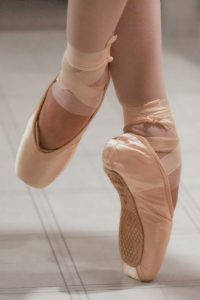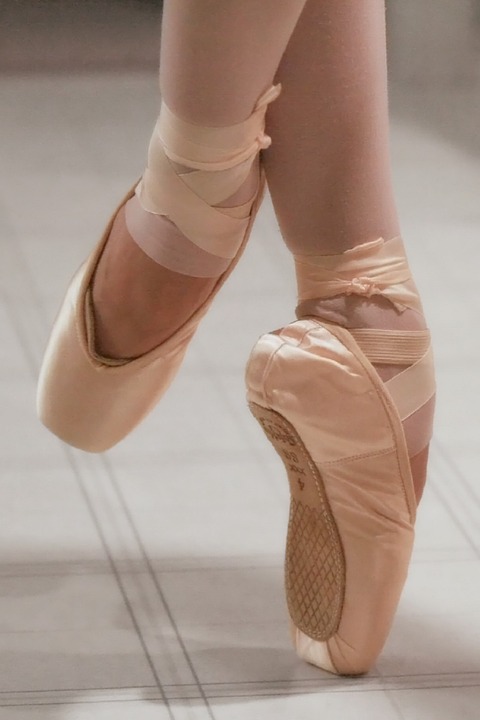
Ballet dancing on pointe has only been happening for the past couple of hundred years. According to pointe shoe history, pointe work is a relatively new and ongoing development. Ballet dancing itself was happening for about 200 years before pointe work even came into the picture.
Technology and advancement on the pointe shoe are ongoing and improving as we learn more about what we can achieve with ballet dancing.
Pointe shoes are mostly handmade which makes them quite expensive. This can prove crippling for the small dance company to keep up with the supply and demand, as they don’t last very long and soften quickly with use. The average pointe shoe can only be danced in for a maximum 12 hours. Professional dancers go through about 120 pairs of shoes a year.
Pointe Shoe History
When ballet first began, dancers used to use heeled slippers, which were not comfortable, and it hindered the dancer’s performance. After a while, it is rumored that Marie Camargo of the Paris Opera Ballet may have been the first dancer to take the heels off of the slippers.
The flat-bottomed slippers became very popular throughout the ballet community, as the dancers felt liberated and free. At first, dancers just used to use normal satin slippers much like today’s soft ballet shoes. The new flat-bottomed slippers worn during the 18th century are much like the soft satin shoes worn by young ballerina’s in classes today. They were secured to the feet with ribbons around the ankle and were pleated under the toes for a better fit. The new slippers allowed for a full extension and enabled the dancer to use the whole foot.
The first dancers to rise up onto their toes did so with an invention made by Charles Didelot in the year 1795. He invented a ‘flying machine’ that lifted dancers allowing them to stand on their toes before leaving the ground.
The light and ethereal qualities displayed were so popular with audiences that choreographers began to look for ways to incorporate more pointe work into their pieces.
As ballet progressed into the 19th century, the emphasis on technical skill increased, as did the desire to dance en pointe without the aid of wires. Marie Taglioni is often credited as being the first to dance on pointe but like many things in the early history of ballet and pointe shoe history, no one knows for sure.
In 1832, when Marie Taglioni first danced the entire La Sylphide en pointe, her shoes were nothing more than modified satin slippers; the soles were made of leather and the sides and toes were darned to help the shoes hold their shapes. Because the shoes of this period offered no support, dancers would pad their toes for comfort and rely on the strength of their feet and ankles for support. They were made slightly stiffer so that a tremendously strong dancer, like Marie Taglioni, could achieve a brief but thrilling balance on the tips of her toes.
These ballet dancing slippers underwent more changes towards the end of the nineteenth century with Italian Ballerinas further reinforcing the toes of their shoes and putting a type of block into the shoe that enabled them to sustain longer balances as well as multiple turns on pointe. Those shoes were a lot less supportive than those of today, but that extra support in the tips of the toes revolutionized ballet technique and dancers were able to achieve so much more on pointe.
The Italians were the first to adopt the strengthened version of the pointe shoe, as well as the spotting heads in their turns. The Russians not wanting to be outdone or out danced quickly adopted the reinforced shoes. The cobblers of those days did the best they could with what they had, but they had no durable synthetics or shock-absorbing foam cushions in the 1890’s, so shoes were made with burlap, leather, paper, canvas and glue.
Anna Pavlova was one of the first to add the stronger leather mid sole to the pointe shoe. It was rumored that she also danced on wider platforms rather than the tiniest point as was the romantic ideal of the time and that the photo‘s of her on pointe were doctored.
Over the years pointe shoes slowly grew heavier and sturdier, as well as widened at the platform. From this, they evolved into different styles and shapes, but even today most are still made the old way. It was not until the late twentieth century that synthetic components made from thermoplastics and urethane foams were successfully introduced into the pointe shoe design.
 Advances in the ballet technique of female dancers owe a large debt to the advances in pointe shoes. With today’s shoes, ballet dancers are able to push the limits of ability and technique. Who knows what new and exciting possibilities still lie ahead for future ballet dancers.
Advances in the ballet technique of female dancers owe a large debt to the advances in pointe shoes. With today’s shoes, ballet dancers are able to push the limits of ability and technique. Who knows what new and exciting possibilities still lie ahead for future ballet dancers.
If you would like to read more on the buying of pointe shoes, you can click here. Another article on buying ballet shoes online will also interest you. Click here.
Most important, as dancers you need to look after those feet like they are your most precious assets.
 Ballet dancing on pointe has only been happening for the past couple of hundred years. According to pointe shoe history, pointe work is a relatively new and ongoing development. Ballet dancing itself was happening for about 200 years before pointe work even came into the picture.
Ballet dancing on pointe has only been happening for the past couple of hundred years. According to pointe shoe history, pointe work is a relatively new and ongoing development. Ballet dancing itself was happening for about 200 years before pointe work even came into the picture. Advances in the ballet technique of female dancers owe a large debt to the advances in pointe shoes. With today’s shoes, ballet dancers are able to push the limits of ability and technique. Who knows what new and exciting possibilities still lie ahead for future ballet dancers.
Advances in the ballet technique of female dancers owe a large debt to the advances in pointe shoes. With today’s shoes, ballet dancers are able to push the limits of ability and technique. Who knows what new and exciting possibilities still lie ahead for future ballet dancers.

Dear Mergie 1
Your website is wonderful . Just enough text , have the right colour , enough Ads , good postings , good comments , good subscribing , and links to social media is good .
I also love the many articles you have that further explains your niche . Also articles that you love that are not relating to your niche . I do not see any selling brand of your niche which is good on the first page . So if people want to buy then they can click on the Ads and go to Amazon .
Perfect all in all .
Cheers !
Alwi
Founder of lokiretards .com
Thanks for the kind words Loki.
Oh ok yeah my partner is smiling sitting next to me, because shes a ballet dancer too and shes taught me a lot about it already, and after feeling like it was a girly thing only, after years of watching it i have found a much deeper appreciation and even enjoyment out of ballet, and Pointe shoes really are iconic of ballet in general.
You should see how many old super worn pairs of these she has in the attic, which she will never get rid of! lol
Yes, I know, it sort of becomes an addiction.
This is a great article and site that really shines light on the history of dancing. I have a sister-in-law and a niece that are dancers who would really enjoy reading this. I will refer them to your site. I really enjoyed reading this as well.. Good stuff, Thanks for sharing!
Glad you found it interesting Jen and thanks for stopping by.